IMED1002 - Chromosome Changes: Number (L28)
1/23
There's no tags or description
Looks like no tags are added yet.
Name | Mastery | Learn | Test | Matching | Spaced |
|---|
No study sessions yet.
24 Terms
How many alleles do we have
2, one from each parent
Numerical chromosomal abnormalities involve
- gain or loss of chromosomes
- Number of chr in a basic set: monoploid number (X). e.g bees, ants, wasps etc, hence they are sterile (except queen bee)
- organisms with multiples of basic chr set = euploids
- normal human cells are either: haploid (one set, n) or diploid (2 sets, 2n)
- these are both normal euploidy
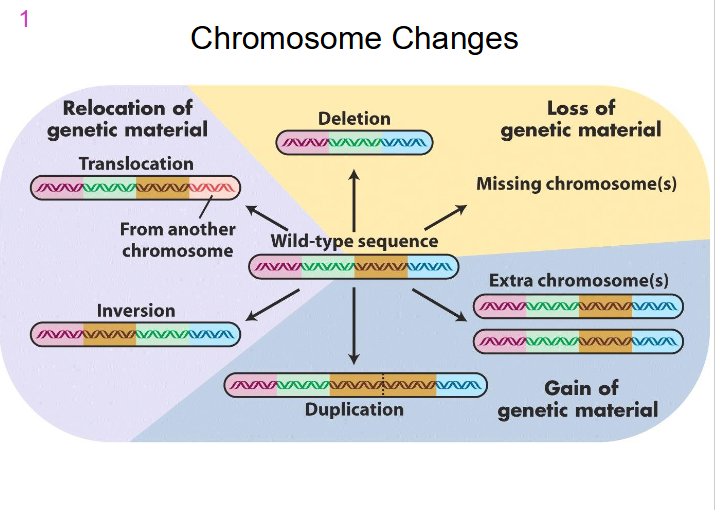
Chromosome Changes
- normal means a human who has all the genes in the correct place
- the sequence shown represents a chromosome
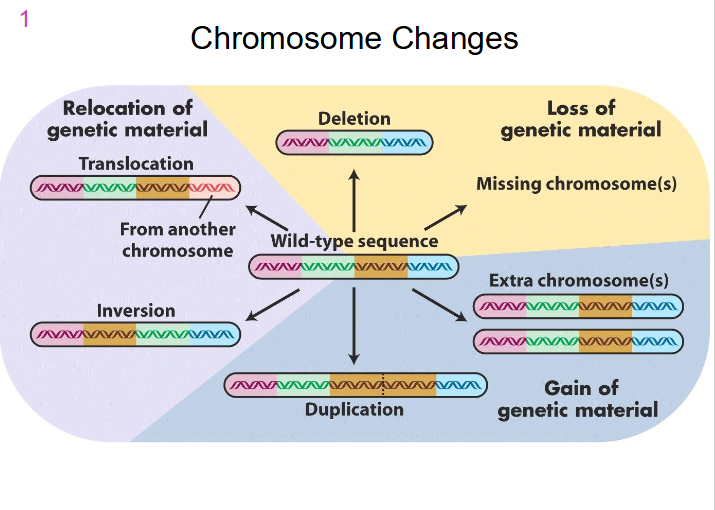
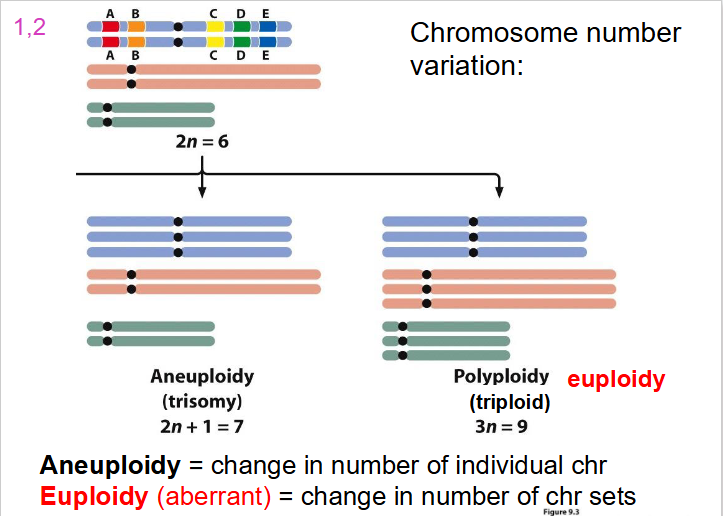
Types of Chromosome Variants (NAMING ONLY)
- three basic categories: aberrant euploidy (polyploidy), aneuploidy, chromosome rearrangements (alter structure, not in these slides)


Aberrant Euploid
one or more complete sets of chromosomes are added/lost
- if you lose a set, you have 23 chr
- if you gain a set, you have 69 chr
- NOT VIABLE for life
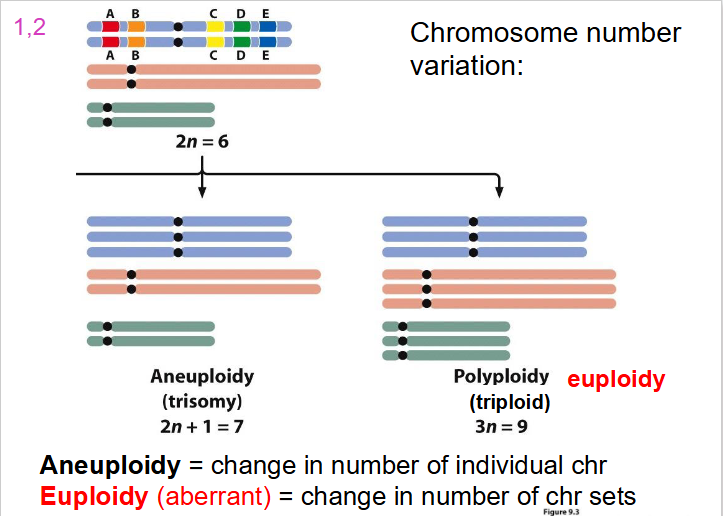
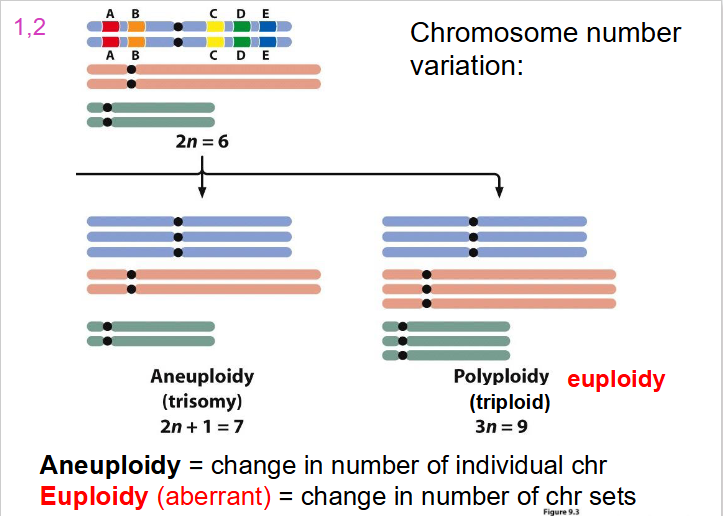
Aneuploid
number of chromosomes is altered (one or more individual chr added or deleted)
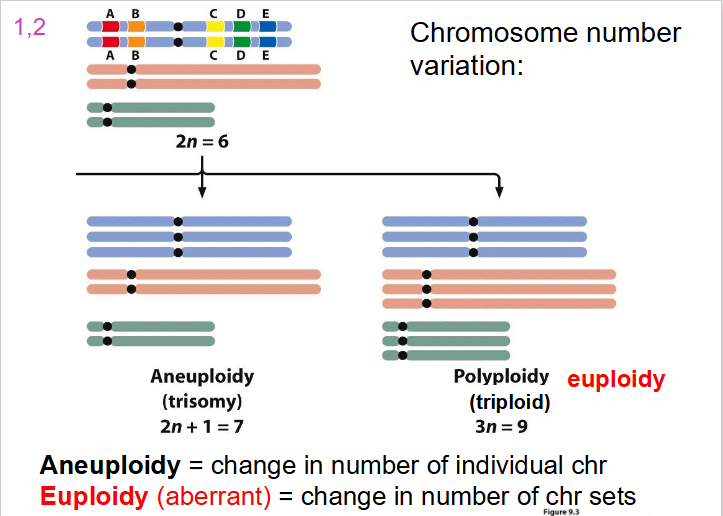

Euploids
- Monoploid: an individual of a "normally" diploid species with one copy of the basic chromosome set = n (not viable in humans)
- Euploid: has multiples of basic chromosome set (e.g Diploid is 2n (normal human), Triploid is 3n (aberrant euploidy)
- Polyploid: More then 2 sets


Aneuploid Designation
- number of chromosomes is altered (one or more individual chr added or deleted)
- Monosomic: 2n-1
- Trisomic: 2n+1
- Nullisomic: 2n-2
- Sex Chromosome Changes: XXY, XYY, XXX or X0 (0=null)
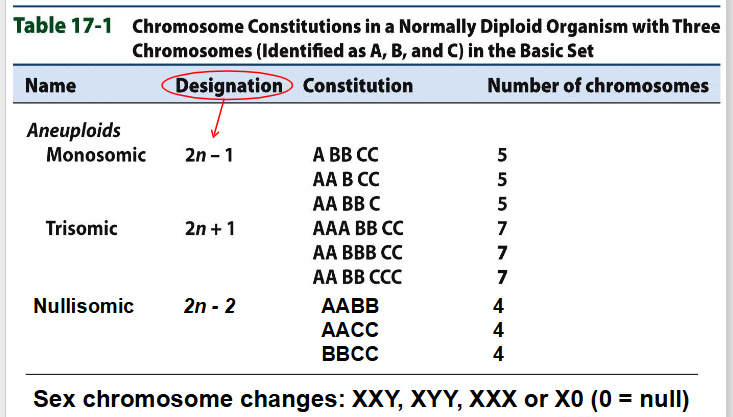
SUMMARY SO FAR
Aneuploidy: change in number of individual chr. Types of Aneuploidy: (n refers to haploid number), the designations are important:
- Nullisomy: loss of both members of homologous set of chr (2n-2) (NOT VIABLE)
- Monosomy: loss of a single chr (2n-1)
- Trisomy: gain of a single chr (2n+1)
- Tetrasomy: gain of 2 homologous chromosomes (2n+2)
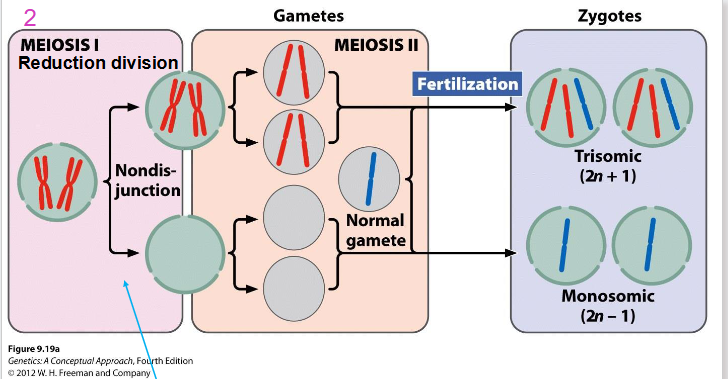
Meiosis and Aneuploid (Nondisjunction at Meiosis 1)
- Aneuploid cells can arise through nondisjunction
- Paired chromosomes fail to separate during meiosis and migrate to same daughter cell
- can occur at 1st meiotic division or second meiotic division
- usually if nondisjunction occurs at meiosis 1 none of these zygotes are going to be viable

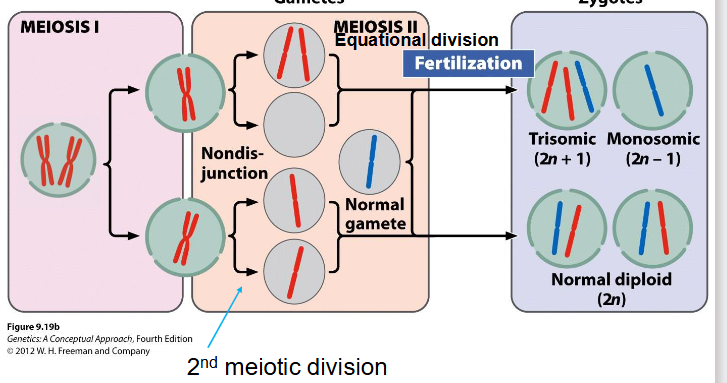
Meiosis and Aneuploid (Nondisjunction at Meiosis 2)
- Human autosomal monosomics not viable, due in in utero
- some human autosomal trisomics are viable

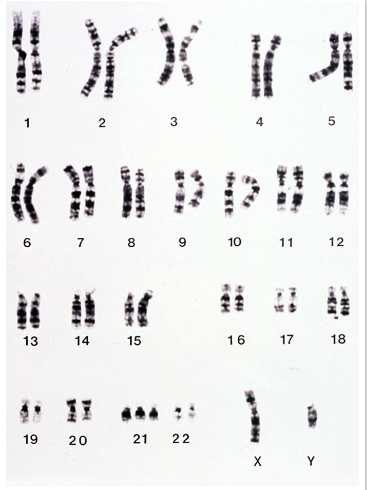
Autosomal Trisomy (2n+1)
- for final exam have to be able to look at a karyogram and tell if its normal or abnormal, if its XX or XY (without numbers beneath them)
- have an extra copy of one autosome
- in diploid organisms, autosomal trisomy generally results in abnormality or death
- however, can have viable trisomics and even fertile trisomics. e.g trisomy 21
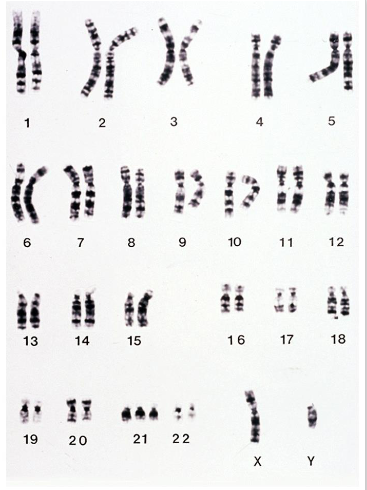
Autosomal Trisomy in Humans
Trisomy 21: Down Syndrome, around 0.15% of live births
- People are viable and active.
- Most Down's patients have extra chromosome 21, sporadic and have no family history of aneuploidy
- Other human trisomy to survive birth: 8, 9, 13, 18 and 22
- severe developmental abnormalities. Other autosomal trisomics due in utero
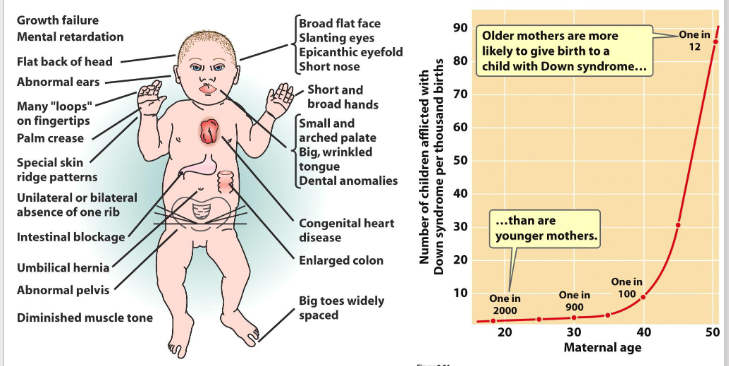
Trisomy 21 Phenotype
- Incidence related to maternal age, cause still not verified. Less pronounced link to paternal age
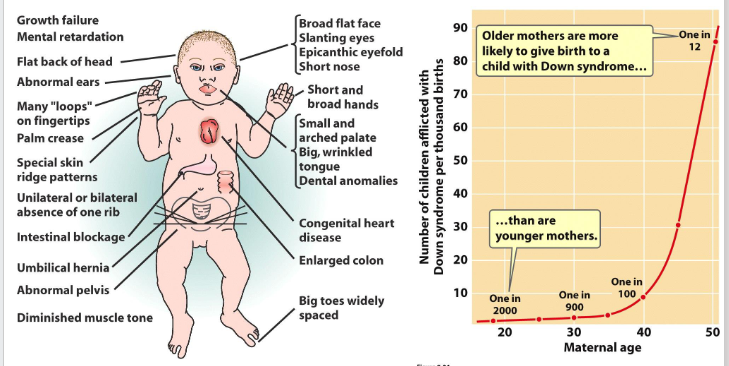
Why does risk of having a child with trisomy increase as you get older
- in euploids, ratio of any one gene to any other is 1:1
- in Aneuploids, ratio differs by 50% from wild type. 50% for monosomics and 150% for trisomics
- This makes the aneuploid genes out of balance
- Generally, the amount of transcript a gene makes is around the number of copes of that gene in a cell
- so the more copies of the gene, the more transcripts and the more protein translated
- called the gene-dosage effect
- e.g if you have two copies of the gene you're gonna have two copies of the transcript. If you have 3 copies of the gene, you're gonna have 3 copies of the transcript
- more copies = more transcripts = more proteins
- to be a viable human, you have to have gene products and proteins in relative balance to one another
Gene Balance
- Normal physiology relies on euploid gene balance, if this is not maintained, may get imbalance in cellular pathways: this is particularly important during development
- the entire aneuploid phenotype is really a combination of all the imbalances of the genes on the chromosome that is missing or present as an extra copy
- Genome imbalance: ratio of genes altered, ratio of gene products altered, change in phenotype, expression of deleterious recessive alleles
Phenotype Changes and Gene Balance
- Phenotype changes may result from only a few "vital" or "major" genes on the chromosome, not necessarily all genes on it
Such genes are said to be:
- haplo-abnormal (if only one gene copy gives an abnormal phenotype) or
- triplo-abnormal (if 3 copies of the gene give an abnormal phenotype) (e.g trisomy 21)
- such genes are known to significantly contribute to the aneuploid phenotype (next lecture)
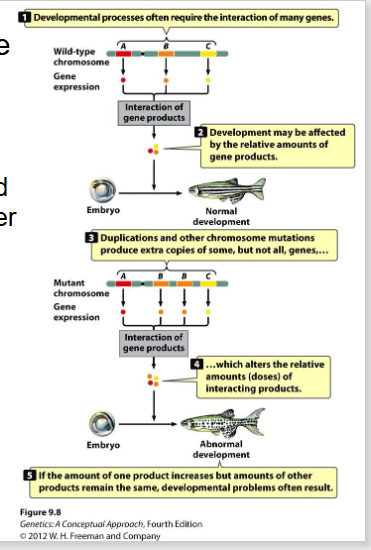
Unbalanced Gene Dosage
- due to imbalance in amounts of gene products
- Amount of protein synthesised often directly related to number of gene copies
- Proper development needs interaction of proteins at correct dosage (thats the reason so many trisomics and monosomics die in utero)
- Sometimes duplications are evolutionarily beneficial. e.g human globin genes

Gene Balance and Sex Chromosomes
- Y chromosome is a degenerate X, with very few functional genes, other then sex determination and/or sperm production
- X chromosome contains vital "housekeeping" genes
- Yet the X chromosome's housekeeping genes are expressed almost equally in males and females, even though females have double the number of these genes: known as dosage compensation
- X chromosome is vital for life
Even though females have double the X chromosoms as males
they only express 1 of these chromosomes in their cells (X chromosome inactivation)
Transcriptionally Active Chromosomes
- in humans, only one X chromosome is transcriptionally active in any somatic cell
- So, both XX and XY individuals have equivalent transcription from their X chromosome genes
- Females are mosaics and have some other cells express genes from the maternal X and other cells from the paternal X
- Such X chromosome "inactivation" also explains why XXX individuals are normal, they transcribe from only one X chromosome in any one cell
X Chromosome Monosomic (2n-1)
- Some X-chr monosomics are viable
- Turner syndrome (X0) 45 chr: 44 autosomes, only 1 X chr. around 1 in 5000 female births (infertile individuals)
Human Sex Chromosome Trisomy
- XXX, phenotypically normal, fertile females. Meiosis gives pairing of only two of the X's. The third X does not pair and is not transmitted. Hence gametes are X only. (The extra X is silenced). Meiosis will give pairing of two of the X chromosomes, and the third one is lost, hence not passed on
- XYY, mostly fertile, no "true" predisposition to violence. Meiosis gives normal pairing of X with one of the Y's. The other Y does not pair and is not transmitted to gametes. The resultant gametes therefore have either X or Y, as any normal gamete does.
- So, for both of these trisomies, the defect is not passed onto the next generation
Aneuploid XXY Male
- aneuploids for X and Y chromosome occur at around 1/1000 live births
- XXY male = Klinefelter syndrome: infertile, slightly lower IQ, lanky build